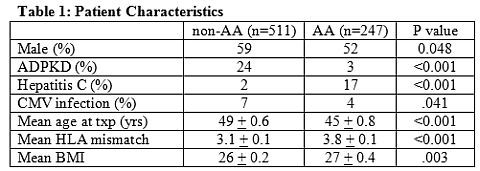Differing Characteristics of New-Onset Diabetes after Transplantation (NODAT) in African-American Compared to Non-African-American Kidney Recipients
Hospital of the University of Pennsylvania, Philadelphia, PA
Meeting: 2013 American Transplant Congress
Abstract number: D1483
Background: NODAT, a common 1st post-transplant year complication, is more prevalent in African-American recipients (AA). Risk factors for, and the clinical course of NODAT are not well defined in this population. Aim: To compare clinical characteristics of NODAT developing within the 1st post-transplant year in AA and non-AA kidney recipients. Methods: We performed a retrospective cohort study in 758 primary kidney recipients without known pre-existing diabetes and transplanted at our center from 1999-2007. NODAT (fasting blood glucose ≥ 126 mg/dl or random blood glucose ≥ 200 mg/dl on 2 separate occasions, or glucose-lowering therapy use) within the 1st post-transplant year was considered transient if, by last follow up, diabetes-range hyperglycemia had resolved and/or glucose lowering therapy was stopped, or persistent if these criteria were still met. Results: Of the entire cohort, 33% were AA. Immunosuppression use was similar in AA and non-AA patients. NODAT occurred in the 1st year in 27% of non-AAs and 34% AAs respectively (P=0.029); by Kaplan-Meier, this difference occurred within the 1st month and continued thereafter (P=0.04). Compared to non-AAs, AA race was associated with persistent (HR 2.8, 95% CI 1.6-4.5, p <0.001) but not transient (HR 0.9, 95% CI 0.5-1.5, p =0.86) NODAT. Unadjusted comparison of AA and non-AA characteristics is shown in table 1; logistic regression analysis of risk factors for NODAT by 1-year post-transplant in table 2. With median follow up of 85.6 months, NODAT was not associated with mortality or graft loss in AA patients. Conclusion: Compared to non-AAs, AA patients have a different risk factor profile for NODAT, and a greater risk that it will be a persistent complication.


To cite this abstract in AMA style:
Wing J, Patel P, Sawinski D, Bleicher M, Goral S, Reese P, Trofe-Clark J, Bloom R. Differing Characteristics of New-Onset Diabetes after Transplantation (NODAT) in African-American Compared to Non-African-American Kidney Recipients [abstract]. Am J Transplant. 2013; 13 (suppl 5). https://atcmeetingabstracts.com/abstract/differing-characteristics-of-new-onset-diabetes-after-transplantation-nodat-in-african-american-compared-to-non-african-american-kidney-recipients/. Accessed December 4, 2025.« Back to 2013 American Transplant Congress
